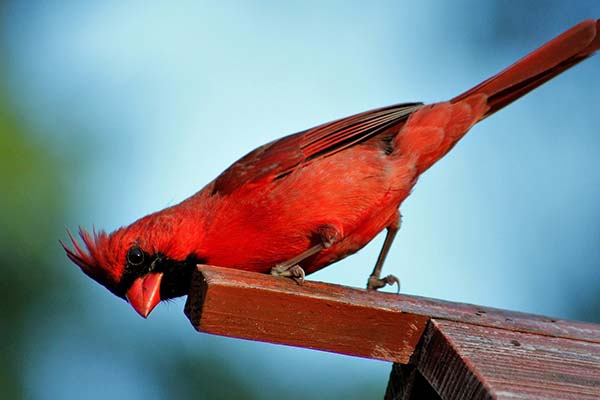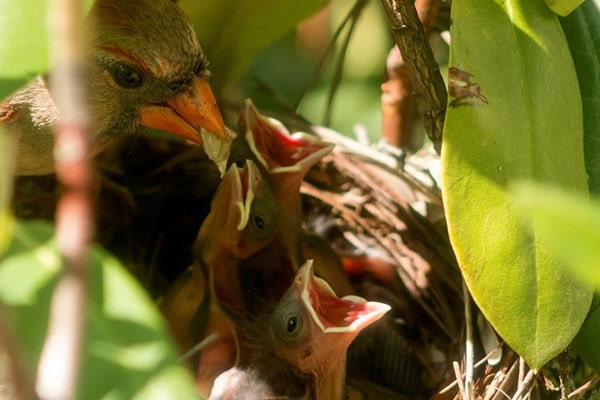Contents
I’ve wondered, “do cardinals use birdhouses” and I’ve researched this topic in-depth to realize that they do not. They don’t care for enclosed structures for their nesting locations. They much prefer an open-air location with lots of branches for cover in either trees, bushes, or densely packed shrubs.
Cardinals prefer to nest in protected areas of trees, shrubs, or bushes. They like densely protected vegetation and will build their nest in the fork of tree branches or well-protected bushes. This is just one way of providing natural protection against any animals seeking harm. Their nests tend to be placed just above ground level up to heights of 15 feet. You will hardly ever see a Cardinal using a birdhouse for nesting.

In this article we will explore:
Why cardinals do not like enclosed birdhouses
and…
How do they make their nests?
and…
What other alternatives can be placed instead
Read further to find out:
- Why they don’t like birdhouses
- Other ways to bring Cardinals to your yard
- Proper placement of your cardinal bird feeders
- Employing nesting shelves
- Answers to FAQs
- Why they don’t like to reuse nests
Why Do Cardinals Not Like Birdhouses?
As a lifelong bird enthusiast, I love inviting birds to both feed and nest in my backyard. Their songs and wonderful colors are such a welcome addition to my yard. I have thoroughly researched why the most widely recognized North American bird doesn’t like to build a nest in a birdhouse.
While it may seem like a perfect setting to build a nest away from predators and the prying eyes of other aggressive birds, they don’t feel comfortable using them. It may seem contradictory since cardinals often build their nests in secluded areas with thick shrubs, bushes, vines, or trees where they can build the nest in the crook of a branch so they feel safe.
With that being the case, why don’t they like birdhouses?
Location, Location, Location
Quite simply, because they are far too enclosed for their liking. Normally, they shape their nests into a tight cup-like shape using anything they can find to shape into a nest.

Items used to make nests:
- Leaves
- Bark
- Hair
- Fur
- Paper
- Twigs
- Grass
And even though they like to place the nest in a location with lots of branches and leaf cover, they still like to be able to see if a predator is approaching. By doing that, they are better prepared to fend off an attack. If they are in an enclosed birdhouse, there is nowhere for them to go if predators attacks and no way to see it coming either.
What’s wrong with birdhouses?
Think about this…
Most birdhouse locations are placed so they are convenient for us to get a good look at our cardinal friends, right?
Well,
those locations typically don’t coincide with the ideal location for the cardinals to nest and feel comfortable.
As bird watchers,
we want them to be right outside our window or just off the porch so we can have a great view of all the activity.
Of course, we want to be able to witness the building of the nest, the mama bird bringing back all the materials to make a proper nest. And who would want to miss out on the females laying the eggs and the babies hatching?
Well, while this is very exciting to think about, we also need to think about our cardinal counterparts and what they need to feel safe and comfortable.
Reasons they won’t use birdhouses:
- Too enclosed
- Unable to see predators approach
- Offers only one exit
- Never place in an ideal location for cardinals
How Mating Season Impacts Nest Location
Believe it or not, cardinals are one of the species in nature that mate for life. They take care of each other and their broods as a team. They make a new nest for each mating season not reusing the old ones. There are two separate mating seasons each year, which means the cardinal pairs require two nests a year.
That’s a lot of work.
So, why do they do it?
Once one brood has been hatched and the male cardinals begin feeding them, the female cardinal is already on the hunt for a new nest location for the next brood. The male will continue to feed the baby birds even after they have left the original nest and can fly and feed on their own. All the while, the female is working on building the next nest.
Cardinals like seeking out sites near their original nest because it confuses predators and makes them think there is more than just one family of cardinals in the area.
Other factors
That is another reason they won’t use birdhouses. They can’t move the birdhouse to another location and cardinals don’t reuse prior nesting sites.
So,
even if a cardinal happened to use a birdhouse, they would never use it again.
Facts to keep in mind:
- Cardinals like nesting 3 to 15 feet off the ground
- They prefer branches of shrubs, bushes, and trees with lots of branch cover
- They never reuse an old nest
Note: Be sure to like our follow us on Facebook or Pinterest.
The Cardinal Nesting Cycle
Female cardinals do all the work when it comes to building a new nest. She seeks the location and gathers materials to build it.
Before you raise your hands in protest…
… male cardinals are busy with their jobs too!
As the females gather everything to get the new nest ready for the next brood, male cardinals protect the females and their offspring. They also continue to feed the baby birds for two weeks after they leave the nest.
During the time that females are incubating their eggs, males repeatedly feed the female. Additionally, they provide any necessary protection against predators or intruders.
So,
don’t bother cardinal families while they are in their nest! Just observe from afar.
By the way, the incubation period is around twelve days. Once hatched, the male begins bringing back food to feed not only the female but also their hatchlings.
How Can I Help Cardinals Nest in My Backyard?
While cardinals do not care for birdhouses in the least, you can give them a location to build a nest on that will offer great views for you and a wonderful nest location for them.
What is it?
It is called a nesting shelf. This a three-sided enclosure with no roof. It allows the cardinals a sturdy foundation to build upon without making them feel enclosed.
Keep in mind,
you should install a nesting shelf at least 5 feet above ground preferably in a shady location such as in the foliage of shrubs or bushes. This will help keep them safe and secure.
The great news is after the young have left the nest, you can clean off the nesting ledge and entice another cardinal family to nest there again.
Closing Thoughts on Do Cardinals Use Birdhouses
We all love bird watching. If you didn’t you wouldn’t be here reading this. And while cardinals are one of the most beautiful and colorful birds in North America, they have their quirks and preferences just like any animal does.
So, the answer to do cardinals use birdhouses is a firm NO.
So be it.
If you would like to help them nest, then please don’t rely on a birdhouse. Set up a nesting platform and let them use that instead. You’ll get to watch the progress from afar, seeing the female working so hard to build the nest and seeing them raise the baby birds will be so incredible to witness. Let them discover the wonderful love you have for them.

